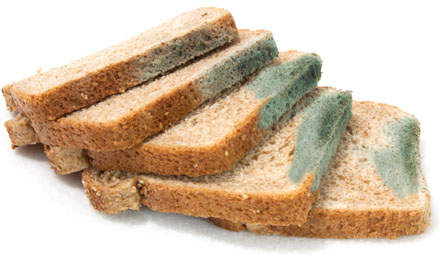Molds are microscopic fungi and live on animal matter or plant. So many species of fungi are still unknown - it is estimated that there are over 300,000 types of fungi. Most of these species are threadlike organisms and produce spores, which can be transported by water, air, or insects. Molds are not like bacteria in that they have many cells. They may look like skinny mushrooms under a microscope. The color of mold is due to the spores. These molds can be quite unhealthy, and that is why many people ask what happens if moldy bread is eaten.Let's find out more about it.

What Happens If You Eat Moldy Bread?
Eating moldy bread can cause certain problems. However, it usually depends on the type of mold you eat because some of them are more dangerous and can cause a serious illness. A number of fungi or bacterium can grow on bread – the most common examples are alimentary toxic aleukia, gangrenous ergotisms, Stachybotryschartarum, and aflatoxicosis.
- The most common issue after eating moldy bread is stomachache; however, what happens definitely depends on the type of mold you eat, but another factor determining its effects is how sensitive you are to mold. Some people are more sensitive than others and they are going to have a serious reaction too. In this case, you may have an upset stomach and find it difficult to breathe. This may require hospitalization as well. Some studies have also found that eating mold can lead to serious nervous system disorders and depression.
- Another very important thing to understand is that sometimes there are multiple chains of mold on bread. It is therefore difficult to determine if the moldy bread you have eaten will lead to a serious reaction. In many instances, people have eaten moldy bread and became seriously ill – some have died as well. Eating moldy bread does not always result in complications because many types of mold are not harmful – some examples include fusarium venenatum, penicilliumroquefortii, and aspergillus oryzae. As you cannot tell what type of mold has grown on your bread, you should simply avoid eating it.
So why do breads get mold in the first place? That usually happens when small spores of mold that can travel through air land on the surface of bread and start rotting it. In a matter of few days, your bread will turn from white to black. Even if you think most part of the loaf is clean, you may be wrong because tiny spores may have already invaded the rest of the loaf – you cannot see them with naked eye. Therefore, you should never eat moldy bread and eating moldy bread after cutting the mold off should also be avoided.
Other Foods with Mold: Eat or Throw Away
Eating moldy food is not a good idea because mold can be toxic. The best idea is to discard the food that looks rotten or has tiny furry spots of mold. Keep in mind that you should avoid sniffing the moldy food because it can release spores in your respiratory tract and cause allergic reactions or other complications. That is the reason why knowing what happens if you eat moldy bread is important. Here is more about other foods with mold that you can or cannot eat.

1. Foods Can Be Eaten
- Dry-cured country hams: you can eat them after scrubbing mold off because these shelf-stable products can have surface mold that are not dangerous.
- Hard cheese: You can eat it because mold cannot penetrate into the product. Still, you should discard the part of cheese that has mold on it. Use a fresh wrap to cover the cheese.
- Firm veggies and fruits: You can consume fruits and veggies like bell peppers, cabbage, carrots, etc., after cutting off the moldy part. Mold cannot penetrate into these dense foods.
2. Foods Should Be Throw Away
After knowing what happens if you eat moldy bread, you have to avoid eating the following moldy foods at all cost.
- Bacon, luncheon meat, and hot dogs: Do not consume these foods because they have high moisture content and there may also be bacteria on the surface with the mold.
- Cooked leftover poultry, meat, and cooked casseroles: These food items have high moisture content that may be contaminated. Besides mold, there may also be bacteria present on the surface.
- Cooked grain and pasta: You should throw away these food items if you they have visible mold because their moisture content may well be contaminated.
- Soft cheese, yogurt, and sour cream: These food items have high moisture content that can get contaminated if there is mold present on the surface. Avoid eating them.
- Jams and jellies: Do not eat moldy jams and jellies, and never try to scoop out the mold to use the remaining condiment. The mold in this case produces a mycotoxin that can be dangerous.
- Legumes, peanut butter, and nuts: Do not eat them if they are moldy.
